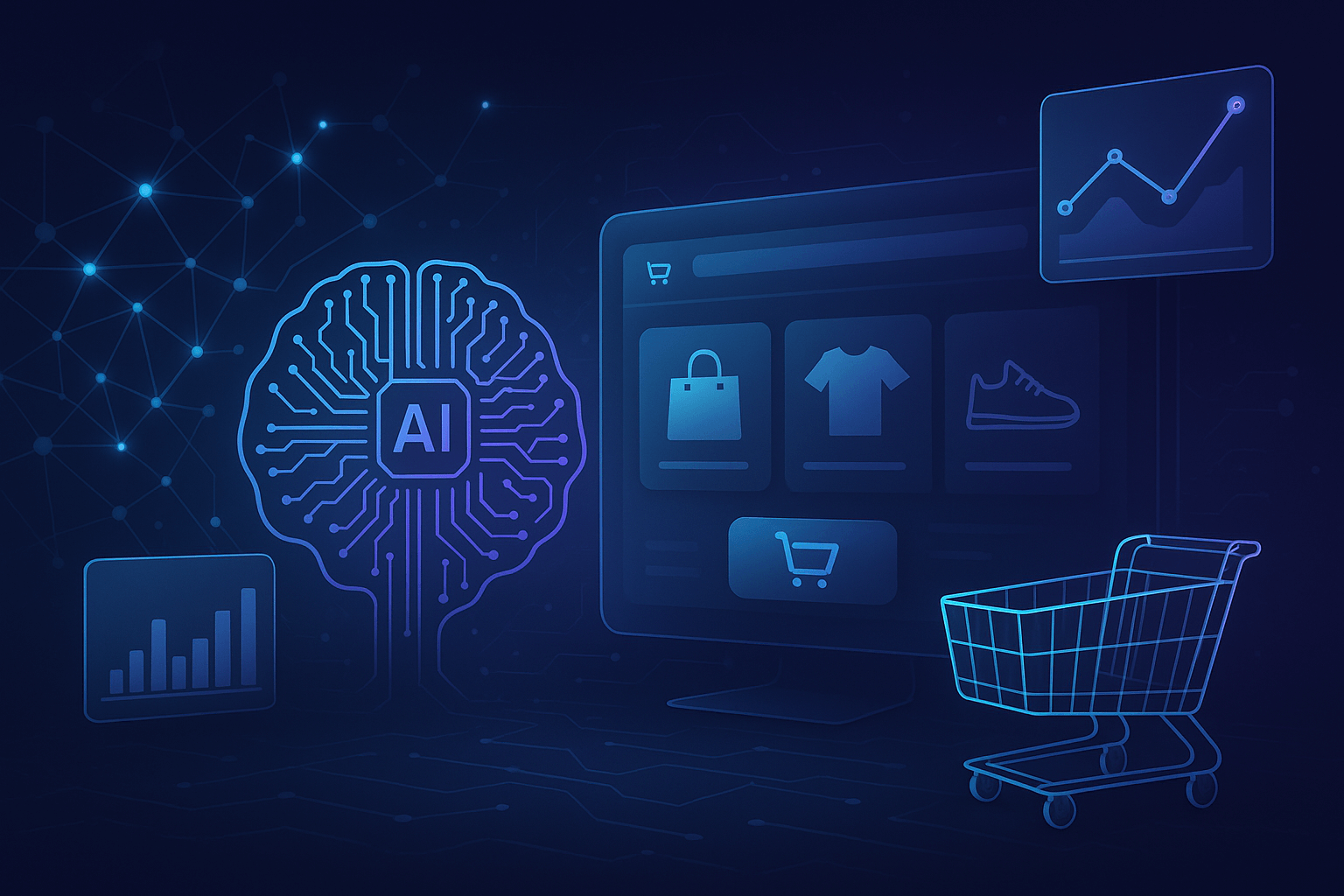From Wake-Up Call to Game Plan
If you’re an ecommerce operator still thinking AI is “interesting” or “worth exploring later,” you’re already behind. The biggest players in the market—Amazon, Walmart, even Shopify itself—aren’t talking about AI as a tool. They’re embedding it into their logistics, inventory modeling, upsell systems, and checkout logic.
Meanwhile, smaller brands are still browsing app stores, hoping a plugin can bridge the gap. But in today’s market, selling online requires more than just bolt-on features, it demands deep intelligence built into your stack.
Let’s be blunt: It can’t.
Because AI isn’t a feature. In today’s landscape, artificial intelligence isn’t optional, it’s the new decision-making layer behind every high-performance ecommerce brand. It’s the new infrastructure of ecommerce. And just like you can’t bolt a second floor onto a collapsing house, you can’t bolt AI onto a rigid, outdated tech stack and expect transformation.
The good news? You don’t need a $500 million R&D budget or a team of PhDs to get in the game.
At Optimum7, we’re already building custom AI stacks for ecommerce stores — not as side projects, but as core systems that power revenue, loyalty, and operational speed. In this article, we’ll show you what that actually looks like, why AI is more than a buzzword, and how you can start integrating it before your competitors do.
The Current Divide: Amazon vs. Everyone Else
Amazon doesn’t dominate 50% of U.S. ecommerce by accident. And no, it’s not just because of two-day shipping or a catchy logo.
It’s because their backend infrastructure, the part you don’t see, is a living, breathing intelligence system.
While most brands are just starting to experiment with automation, Amazon’s already built a battlefield where every click, scroll, and shipment is tracked, predicted, and optimized in real-time. They’re not using AI to save time. They’re using it to control time, shaving milliseconds off each transaction, compounding billions in profit.
Here’s just a taste of what Amazon’s AI infrastructure does today:
- Real-Time Demand Prediction: Anticipates what buyers will need before they search for it, based on behavior, weather, time of day, and regional data.
- AI Logistics: Route fulfillment not just by geography, but by urgency, inventory risk, and profit margin potential.
- Quantum-Informed Supply Chain: Allocates manufacturing and sourcing based on simulated economic scenarios, optimizing against volatility.
- Micro-Speed Optimization: Refines page load times, checkout flow, and product positioning down to the millisecond, because at scale, milliseconds = millions.
And yet… most ecommerce stores are still arguing over whether to install live chat or which upsell app to test.
The gap isn’t just wide. It’s existential.
And if you’re still viewing AI as a “feature” you’ll get around to it someday; Amazon already passed you three exits ago.
Why Most Ecommerce Websites Are Stuck in the App Trap
Here’s the uncomfortable truth: most ecommerce businesses think they’re adopting AI… but they’re just installing apps.
There’s a massive difference between using AI and integrating it.
Visit the Shopify App Store or BigCommerce Marketplace and you’ll find endless tools that promise AI this, machine learning that, predictive something-or-other. But when you peel back the surface, these apps are usually limited, disconnected, and painfully generic. They’re designed to work for everyone, which means they’re optimized for no one.
So what does it mean? A bloated, fragmented tech stack full of:
- Redundant upsell apps that don’t talk to your inventory.
- “AI search bars” that still rely on keyword matching.
- Chatbots that answer questions but don’t convert visitors.
- Pricing tools that ignore location, behavior, or margin thresholds.
Ecommerce operators fall into this trap for understandable reasons. It’s easy. It’s low-risk. It looks like progress.
But here’s the catch: when your AI sits on top of broken infrastructure, all you’ve done is decorate a house with no foundation. You’re still making decisions based on guesswork. You’re still reactive. And you’re still trapped in manual workflows, just with shinier dashboards.
The real risk isn’t that these apps fail — it’s that they lull you into a false sense of innovation.
Because while you’re tinkering with plugins, your competitors are integrating AI deep into the bones of their operations. They’re building systems that:
- Adapt pricing in real-time based on demand and profitability.
- Show different product assortments to different users based on behavior.
- Trigger fulfillment workflows before the order is even placed.
You can’t patchwork your way to Amazon-level infrastructure.
And no app — no matter how shiny — will turn your store into an intelligent, self-optimizing machine.
That takes intention. That takes architecture.
And that’s exactly what we’ll break down next.
What AI Integration Looks Like
Let’s strip away the buzzwords and talk about what real AI integration actually means inside a modern ecommerce business.
It doesn’t mean you install a chatbot and call it a day. It means you rewire your store’s nervous system, so that intelligence flows through every layer of the customer experience and operational backend.
At Optimum7, we’re not theorizing. We’re building. These are the AI systems we’re actively implementing for ecommerce clients right now:
1. AI-Driven Search & Filters
Most ecommerce search bars are dumb. They rely on exact keyword matches and static filter logic.
We’re replacing that with AI-powered systems that:
- Understand intent, not just input.
- Predict what the user is likely looking for — even if they don’t type it exactly.
- Dynamically reorder products based on what’s trending, who’s searching, and what’s in stock.
Think about this, a technician searching for a replacement pump will see different results than a purchasing manager, even if they type the same product code. Why? Because AI understands their behavior profiles and purchasing history.
2. AI-Powered Pre & Post-Checkout Upsells
Forget static product bundles. True AI upsells are trained on:
- Past purchase behavior
- Cart composition
- Seasonality
- Real-time inventory availability
Imagine showing a customer the perfect add-on in the cart — not because you guessed, but because your system knew it would raise average order value by 18%. These micro-decisions can dramatically increase AOV and LTV, especially for customers making repeat online purchases with personalized patterns. Now imagine that upsell changes post-checkout based on margin potential, shipping logic, and LTV data. That’s what we’re deploying.
3. AI-Based Single Sign-On (SSO)
The moment someone visits your store, AI should begin customizing their experience, even before they log in. That experience should begin the moment they land, your online store must recognize, respond, and adapt before the customer takes action.
We’re building SSO logic that connects user behavior, device data, and known accounts across platforms. That means:
- Recognizing returning customers automatically
- Pre-loading personalized catalogs
- Skipping redundant friction points
Think of it like ecommerce facial recognition — minus the creepiness. It’s identity + context = frictionless UX.
4. Location-Based Dynamic Pricing
This isn’t discounting. This is precision.
AI-driven pricing adapts to:
- Geo-based demand and fulfillment costs
- Time-based incentives (e.g. reduce dead inventory by 5 PM Friday)
- Competitor pricing data feeds
- Inventory thresholds and margin targets
The result? A store that protects margin without sacrificing conversion, and adjusts in real time to make sure that happens.
These aren’t features. They’re frameworks.
They turn your ecommerce site from a static brochure into a living system that thinks, adapts, and improves itself over time.
And here’s the kicker: you can’t get this from the Shopify App Store.
Why?
That’s what we’ll cover next.
Why Legacy Apps Can’t Power Modern Ecommerce Business Models
If you’re looking for the kind of AI systems we just described, truly adaptive, margin-smart, LTV-aware, you won’t find them in the Shopify App Store. Or the BigCommerce Marketplace. Or any SaaS bundle that promises “AI in 3 clicks.”
Like we said before, apps are built for the average.
They have to work across thousands of stores, with unknown data quality, unpredictable workflows, and no access to their backend logic. That means:
- They can’t sync with your ERP or fulfillment model.
- They can’t leverage your unique sales cycles or pricing strategy.
- They can’t interpret your specific customer intent signals.
In other words, they can’t think like your business, because they weren’t built for your business.
Let’s make it real.
You might install an AI search plugin that helps users find products. But it won’t know:
- Which SKUs you’re trying to push this quarter
- Which products have low margin but high churn protection
- How to differentiate between a returning contractor and a first-time distributor.
You might install a dynamic pricing tool, but it won’t understand:
- Which warehouses are overstocked.
- Which items can’t ship to specific zip codes.
- How to preserve profitability across bundled SKUs with complex sourcing logic.
These aren’t limitations of AI. They are limitations of generic AI.
And when you try to use generic tools for specific challenges, you create more friction, not less. You burn cycles trying to hack the system into place. You introduce gaps between data, intention, and outcome.
That’s why at Optimum7, we don’t build apps. We build custom AI infrastructure that fits your business like a tailored suit.
No fluff. No duct tape. No “good enough for now.”
Because in the next section, you’ll see why “good enough” isn’t good enough anymore, not when AI becomes the core operating layer of ecommerce.
How to Build Your AI Stack — The Right Way
Think of your ecommerce business like a body. The storefront is the face, the backend is the skeleton, and your operations are the muscles. So what’s AI?
The nervous system.
It connects everything — sensing, responding, adapting — so that no part of the body acts in isolation. But for that to work, you need an actual stack. Not a string of disconnected tools. A real AI stack has layers — each one feeding the next, creating compound intelligence across your business.
Here’s what that looks like when we build it at Optimum7:
Layer 1: The Data Foundation
Before AI can act intelligently, it needs something to think with. That means:
- Clean, structured customer data (purchase history, segmentation, behavior tracking)
- Inventory and warehouse logic (SKU performance, margins, aging stock)
- Sales velocity data and conversion patterns
- Source-of-truth integrations with your ERP, CRM, or OMS
We build this layer first because, without context, your AI is just guessing.
Layer 2: Intelligence at the Point of Interaction
This is where users feel the difference. AI begins to:
- Personalize product search and filtering based on intent
- Trigger context-aware upsells during and after checkout
- Dynamically adjust pricing by region, device, or customer type
- Recommend support content before someone even contacts you
This layer turns passive interfaces into proactive decision engines — shortening the path to purchase, increasing AOV, and reducing friction across the funnel.
Layer 3: Backend Automation and Optimization
Behind the scenes, AI starts managing complexity at scale:
- Predicts inventory needs based on seasonality and customer demand
- Flags risky orders or fraud attempts using real-time behavioral analysis
- Automates ticket routing and FAQ resolution in support flows
- Scores leads or accounts based on lifetime value potential, not just order size
This is where the compounding begins. Every system talks to every other system. Decisions improve over time. Manual processes quietly disappear.
The Glue: Feedback Loops
The real secret? The AI learns.
It doesn’t just execute logic — it tests, evaluates, and adapts. Search algorithms evolve based on click-through rates. Upsell engines refine themselves based on conversion success. Inventory models adjust based on real-world fulfillment speed and return behavior.
And all of it is invisible to your customer — except for the part where their experience gets faster, smarter, and more relevant every time.
Why This Stack Beats Any App Bundle
Because it’s built around your business, not someone else’s template.
- It knows your margin thresholds.
- It understands your fulfillment complexity.
- It adapts to your customer lifecycle.
It’s not a shiny tool. It’s an operating system.
And you don’t need to build it all at once. The smartest path is a phased roadmap, starting with high-impact layers and scaling up intelligently.
Where to Start: A Practical AI Integration Roadmap
You don’t need to rebuild your entire ecommerce business overnight. In fact, you shouldn’t.
The smartest AI transformations don’t start with everything — they start with what matters most: the systems that move the needle today, while quietly preparing your business for the complexities of tomorrow.
Here’s a phased roadmap we use at Optimum7 to guide ecommerce clients through AI integration — not as a tech upgrade, but as a growth architecture.
Phase 1: Intelligence on the Frontend
Start where customers feel the difference. These are the high-visibility upgrades that improve experience and conversion instantly.
- AI-Driven Site Search & Filters: Replace keyword search with predictive, intent-aware logic.
- Dynamic Product Reordering: Re-rank search and category pages based on personalization signals.
- Pre-Checkout and Post-Checkout Upsells: Trigger context-specific offers based on real-time cart behavior.
Why it matters: You increase AOV, reduce bounce, and create momentum for deeper changes — all while collecting richer behavioral data. And because customers find what they need faster, customer satisfaction improves alongside revenue.
Phase 2: Intelligence in Operations
Once your customer-facing layers are smarter, turn inward. Now it’s time to remove the friction from your team’s workflow and optimize the economics behind the scenes.
- Inventory Prediction Models: Forecast SKU velocity and automate restock recommendations.
- AI-Powered Fulfillment Logic: Route orders based on speed, margin, and inventory dispersion.
- Support Automation: Triage tickets, resolve common issues, and surface high-risk cases instantly.
Why it matters: You save costs, eliminate human bottlenecks, and gain visibility into operational inefficiencies, without needing to scale headcount.
Phase 3: Intelligence in Customer Relationships
This is the high-leverage layer. Once your store knows your customers, it can build loyalty on autopilot.
- Predictive LTV Segmentation: Identify high-value customers earlier and treat them differently.
- Churn Prediction Engines: Flag buyers who are slipping — and automate win-back offers.
- Personalized Email & SMS Logic: Move beyond “abandoned cart” and into moment-based messaging.
Why it matters: Retention goes up, CAC goes down, and your brand becomes irreplaceable in the eyes of the customer, because they feel understood, not targeted.
Where to Begin (If You’re Not Sure)
If you don’t know where to start, ask this:
“Where am I leaking the most money today — and what decisions are still based on guesswork?”
Then attack that first. That’s the ground zero for AI.
And here’s the kicker: every layer you implement makes the next one more powerful. This is stack thinking, and it compounds.
But wait too long, and the stack won’t just be harder to build — it’ll be irrelevant. Because your competitors are already stacking theirs.
The Real Risk Is Waiting
There’s a myth in ecommerce — that waiting is the safe move. It’s wise to “see how AI plays out” or “wait for the tech to mature.”
Let’s be clear: that window has already closed.
The brands that hesitated during mobile commerce lost a decade. The ones that delayed email automation missed out on millions. And now, with AI, the stakes are even higher — because this is an infrastructure shift.
Waiting doesn’t mean you avoid risk.
It means you absorb:
- Higher CAC as competitors personalize at scale.
- Lower LTV as others trigger smarter retention workflows.
- Operational bloat as your processes stay manual while theirs get leaner.
- Lost revenue from abandoned carts, mistimed promotions, and one-size-fits-all experiences.
Even worse — it’s invisible.
You won’t see an alert telling you that you missed a $250,000 upsell opportunity because your checkout logic wasn’t smart enough. You won’t get a Slack message showing you how much inventory you over-ordered because your forecast was a gut call, not a trained model.
You’ll just keep moving. And slowly, quietly, you’ll fall behind.
Until you wake up and realize you’ve been optimized out of the customer journey.
So if you’re waiting for a sign, this is it.
Build What Amazon Can’t Copy
Amazon can outspend you. Outship you. Outdo you.
But they can’t be you.
Your products. Your customers. Your unique process logic. Your brand promise. That’s the moat — and AI is how you protect and scale it.
At Optimum7, we don’t sell generic AI tools. We build custom AI systems around your business, so your store becomes smarter, faster, and more profitable with every click.
If you’ve watched the videos, you know what’s coming. If you’ve read this far, you know what’s at stake.
Let’s build your ecommerce AI stack — not as a feature. But as for your future.
Start at Optimum7.com or Contact Us now for a strategy call.










